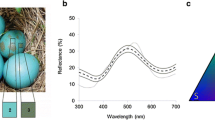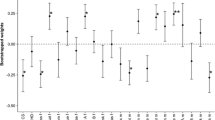Abstract
Hosts of avian brood parasites often use visual cues to reject foreign eggs, and several lineages of brood parasites have evolved mimetic eggshell coloration and patterning to circumvent host recognition. What is the mechanism of parasitic egg color mimicry at the chemical level? Mimetic egg coloration by Common Cuckoos Cuculus canorus is achieved by depositing similar concentrations of colorful pigments into their shells as their hosts. The mechanism of parasitic egg color mimicry at the chemical level in other lineages of brood parasites remains unexplored. Here we report on the chemical basis of egg color mimicry in an evolutionarily independent, and poorly studied, host-parasite system: the Neotropical Striped Cuckoo Tapera naevia and one of its hosts, the Rufous-and-white Wren Thryophilus rufalbus. In most of South America, Striped Cuckoos lay white eggs that are identical to those of local host species. In Central America, however, Striped Cuckoos lay blue eggs that match those of the Rufous-and-white Wren, suggesting that blue egg color in these cuckoo populations is an adaptation to mimic host egg appearance. Here we confirm that Striped Cuckoo eggs are spectrally similar to those of their hosts and consistently contain the same major eggshell pigment, biliverdin. However, wren eggshells lacked protoporphyrin, which was present in the parasitic cuckoo eggshells. Furthermore, biliverdin concentrations were significantly lower in cuckoo eggshells than in host eggshells. Similarity of host-parasite eggshell appearance, therefore, need not always be paralleled by a quantitative chemical match to generate effective visual mimicry in birds.



Similar content being viewed by others
References
Brooker MG, Brooker LC (1991) Eggshell strength in cuckoos and cowbirds. Ibis 133:406–413
Brulez K, Miksik I, Cooney CR, Hauber ME, Lovell PG, Maurer G, Portugal SJ, Russell D, Reynolds J, Cassey P (2016) Eggshell pigment composition co-varies with phylogeny but neither with life history nor with nesting ecology traits of British passerines. Ecol Evol 6:1637–1645
Cassey P, Ewen JG, Blackburn TM, Hauber ME, Vorobyev M, Marshall NJ (2008) Eggshell colour does not predict measures of maternal investment in eggs of Turdus thrushes. Naturwissenschaften 95:713–721
Cassey P, Thomas GH, Portugal SJ, Maurer G, Hauber ME, Grim T, Lovell PG, Miksik I (2012) Why are birds’ eggs colourful? Eggshell pigments covary with life history and nesting ecology among British birds. Biol J Linn Soc 106:657–672
Davies NB (2000) Cuckoos, cowbirds and other cheats, First edn. T & AD Poyser Ltd., London
de la Colina MA, Pompilio L, Hauber ME, Reboreda JC, Mahler B (2012) Different recognition cues reveal the decision rules used for egg rejection by hosts of a variably mimetic avian brood parasite. Anim Cogn 15:881–889
de Marsico MC, Gantchoff MG, Reboreda JC (2012) Host–parasite coevolution beyond the nestling stage? Mimicry of host fledglings by the specialist screaming cowbird. Proc R Soc Lond B 279:3401–3408
Dearborn DC, Page SM, Dainson M, Hauber ME, Hanley D (2017) Eggshells as hosts of bacterial communities: an experimental test of the antimicrobial egg coloration hypothesis. Ecol Evol 7:9711–9719
Fossøy F, Sorenson MD, Liang W, Ekrem T, Mosknes A, Møller AP, Rutila J, Røskaft E, Takasu F, Yang C, Stokke BG (2016) Ancient origin and maternal inheritance of blue cuckoo eggs. Nat Commun 7:10272
Gorchein A, Lim CK, Cassey P (2009) Extraction and analysis of colourful eggshell pigments using HPLC and HPLC/electrospray ionization tandem mass spectrometry. Biomed Chromatogr 23:602–606
Gosler AG, Connor OR, Bonser RHC (2011) Protoporphyrin and eggshell strength: preliminary findings from a passerine bird. Avian Biol Res 4:214–223
Grim T (2005) Mimicry vs. similarity: which resemblances between brood parasites and their hosts are mimetic and which are not? Biol J LinnSoc 84:69–78
Hanley D, Grim T, Cassey P, Hauber ME (2015) Not so colourful after all: eggshell pigments constrain avian eggshell colour space. Biol Lett 11:20150087
Hauber ME (2014) The book of eggs. University of Chicago Press, Chicago
Hauber ME, Dainson M, Baldassarre DT, Hossain M, Holford M, Riehl C (2018) The perceptual and chemical basis of egg discrimination in communally nesting greater anis (Crotophaga major). J Avian Biol. https://doi.org/10.1111/jav.01776
Honza M, Polacikova L, Prochazka P (2007) Ultraviolet and green parts of the colour spectrum affect egg rejection in the song thrush (Turdus philomelos). Biol J Linn Soc 92:269–276
Igic B, Greenwood DR, Palmer DJ, Cassey P, Gill BJ, Grim T, Brennan PR, Bassett SM, Battley PF, Hauber ME (2010) Detecting pigments from the colourful eggshells of extinct birds. Chemoecol 20:43–48
Igic B, Cassey P, Grim T, Greenwood DR, Moskat C, Rutila J, Hauber ME (2012) A shared chemical basis of avian host-parasite egg colour mimicry. Proc R Soc Lond B 279:1068–1076
Ishikawa SI, Suzuki K, Fukuda E, Arihara K, Yamamoto Y, Mukai T, Itoh M (2010) Photodynamic antimicrobial activity of avian eggshell pigments. FEBS Lett 584:770–774
Langmore NE, Stevens M, Maurer G, Heinsohn R, Hall ML, Peters A, Kilner RM (2011) Visual mimicry of host nestlings by cuckoos. Proc R Soc Lond B 278:2455–2463
Mark MM (2013) Host-specific parasitism in the Central American striped cuckoo, Tapera naevia. J Avian Biol 44:445–450
Miksik I, Eckhardt A, Sedlakova P, Mikulikova K (2007) Proteins of insoluble matrix of avian (Gallus gallus) eggshell. Connect Tissue Res 48:1–8
Moreno J, Lobato E, Morales J, Merino S, Tomas G, la Puente JM, Sanz JJ, Mateo R, Soler JJ (2006) Experimental evidence that egg color indicates female condition at laying in a songbird. Behav Ecol 17:651–655
Payne RB (2005) Bird families of the world: cuckoos. Oxford University Press, Oxford
Portugal SJ, Bowen J, Riehl C (2018) A rare mineral, vaterite, acts as a shock absorber in the eggshell of a communally nesting bird. Ibis 160:173–178
Schuetz JG (2005) Low survival of parasite chicks may result from their imperfect adapation to hosts rather than expression of defenses against parasitism. Evolut 59:2017–2024
Soler JJ, Møller AP, Soler M, Martinez JG (1999) Interactions between a brood parasite and its host in relation to parasitism and immune defence. Evol Ecol Res 1:189–210
Sorenson MD, Payne RB (2005) A molecular genetic analysis of cuckoo phylogeny. Pp. 68–94 in RB Payne. Bird Families of the World: Cuckoos. Oxford University Press
Sparks NHC (1994) Shell accessory materials: structure and function. In: Board RG, Fuller R (eds) Microbiology of the avian egg. Chapman & Hall, London, pp 25–42
Stoddard MC, Hauber ME (2017) Colour, vision and coevolution in avian brood parasitism. Phil Trans R Soc Lond B 372:20160339
Stoddard MC, Kilner RM, Town C (2014) Pattern recognition algorithm reveals how birds evolve individual egg pattern signatures. Nat Commun 5:4117
Verdes A, Cho W, Hossain M, Brennan PLR, Hanley D, Grim T, Hauber ME, Holford M (2015) Nature’s palette: characterization of shared pigments in colorful avian and mollusk shells. PLoS One 10:e0143545
Yang C, Liang W, Cai Y, Shi S, Takasu F, Møller AP, Antonov A, Fossøy F, Moksnes A, Røskaft E, Stokke BG (2010) Coevolution in action: disruptive selection on egg colour in an avian brood parasite and its host. PLoS One 5:e10816
Yang C, Huang Q, Wang L, Du WG, Liang W, Møller AP (2018) Keeping eggs warm: thermal and developmental advantages for parasitic cuckoos of laying unusually thick-shelled eggs. Sci Nat 105:10
Acknowledgements
Funding was provided by the Human Frontier Science Program and the Harley Jones Van Cleave Professorship at the University of Illinois (to MEH). MH also acknowledges funding from the Camille and Henry Dreyfus Teacher-Scholar Award and NSF awards CHE-1247550 and CHE-1347065. We thank the Hunter College Chemistry Department and its mass spectrometry core facility, which is supported by the City University of New York, the National Science Foundation, and the National Institute on Minority Health and Health Disparities of the National Institutes of Health. The Lower Colorado River Multi-Species Conservation Program provided funding that allowed collection of Yellow-billed Cuckoo eggshells used in this study. This work was conducted under IACUC permits 2002-1228 from Stony Brook University and 2015-0601-2018 from the Smithsonian Tropical Research Institute. For additional samples, we thank the Wildlife Conservation Society’s Bronx Zoo.
Author information
Authors and Affiliations
Corresponding author
Rights and permissions
About this article
Cite this article
Dainson, M., Mark, M., Hossain, M. et al. How to Make a Mimic? Brood Parasitic Striped Cuckoo Eggs Match Host Shell Color but Not Pigment Concentrations. J Chem Ecol 44, 940–946 (2018). https://doi.org/10.1007/s10886-018-0986-5
Received:
Revised:
Accepted:
Published:
Issue Date:
DOI: https://doi.org/10.1007/s10886-018-0986-5




